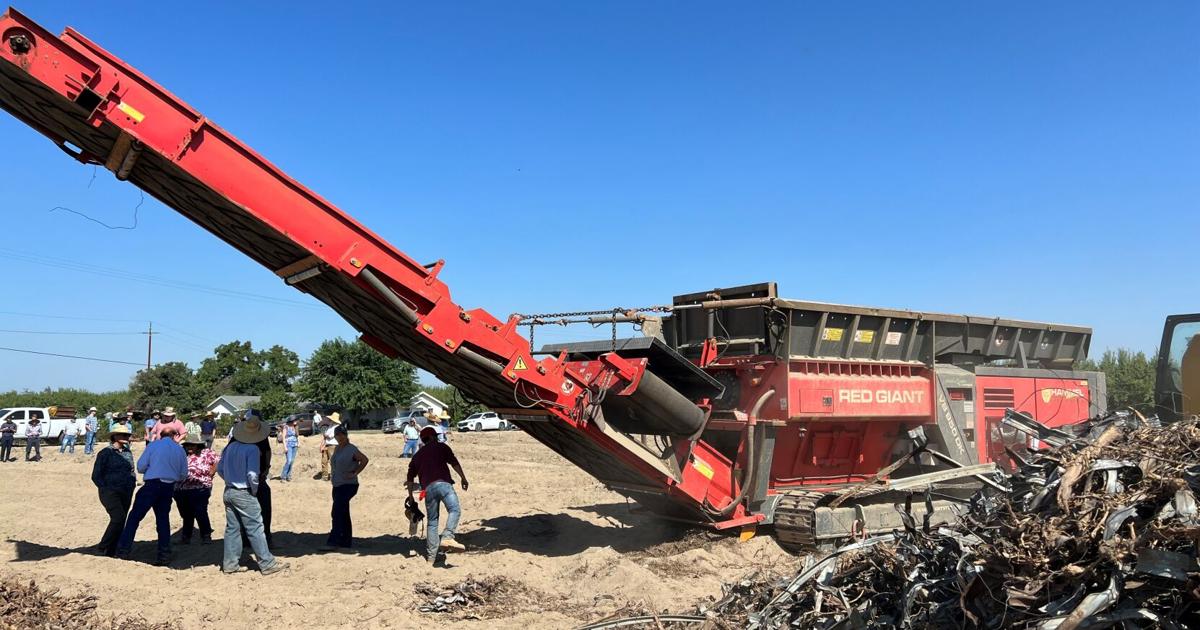Grant money helps farmers purchase new equipment
Grant money helps farmers purchase new equipment | Patterson ... Tank Town Media


Sustainable Agricultural Practices in the San Joaquin Valley

Introduction
Sustainable agricultural practices on smaller farms can be challenging. In response to this issue, the San Joaquin Valley Air Pollution Control District has established a grant program to address the problem.
Demonstration of Sustainable Equipment
Recently, officials visited a Fresno area farm to witness a demonstration of the Hammel vineyard chipping equipment. This equipment, funded in part through the Burn Alternatives Grant Program, has the unique ability to fully chip vineyard material that contains imbedded wire and stakes. This reduces the laborious process of hand removal. The grant program aims to incentivize open burning alternatives in preparation for 2025, when a near complete phase-out of agricultural open burning in the Valley will take effect.
Additionally, officials visited a Kerman area farm to observe the Tenias low-dust nut harvester equipment. This equipment shakes the almonds into a catcher and then drops the nuts into windows in one pass. The Valley Air District has incentivized this equipment through the Low Dust Nut Harvester grant program, as it plays a pivotal role in reducing localized air quality problems associated with nut harvesting.
Importance of Sustainable Practices
“Given that the agricultural community is key in helping the valley meet clean air goals, these programs must remain relevant and responsive to the needs in the field,” stated Stanislaus Supervisor and Air District Governing Board Chair Vito Chiesa. “We must ensure all farmers, especially small farmers, have an opportunity to receive Air District funding to replace their dirty equipment and practices with effective, cleaner options.”
Impact of Joint Efforts
Through these and other joint efforts, over 12,500 old high-polluting agricultural pieces of equipment have been replaced, and the open burning of nearly 5,400,000 tons of woody waste has been eliminated through non-burning alternative practices.
Additional Support
The Air District also offers a variety of programs to support Valley residents, businesses, and public agencies with cleaner equipment, vehicles, and practices. For more information, visit www.valleyair.org/grants or call the grants team at 559-230-5800.
SDGs, Targets, and Indicators
-
SDG 13: Climate Action
- Target 13.2: Integrate climate change measures into national policies, strategies, and planning
- Indicator: The implementation of sustainable agricultural practices and the reduction of open burning in the San Joaquin Valley
-
SDG 15: Life on Land
- Target 15.1: Ensure the conservation, restoration, and sustainable use of terrestrial and inland freshwater ecosystems and their services
- Indicator: The reduction of air pollution and improvement of air quality through the adoption of low-dust nut harvester equipment and vineyard chipping equipment
Table: SDGs, Targets, and Indicators
| SDGs | Targets | Indicators |
|---|---|---|
| SDG 13: Climate Action | Target 13.2: Integrate climate change measures into national policies, strategies, and planning | The implementation of sustainable agricultural practices and the reduction of open burning in the San Joaquin Valley |
| SDG 15: Life on Land | Target 15.1: Ensure the conservation, restoration, and sustainable use of terrestrial and inland freshwater ecosystems and their services | The reduction of air pollution and improvement of air quality through the adoption of low-dust nut harvester equipment and vineyard chipping equipment |
Analysis
The article highlights the efforts of the San Joaquin Valley Air Pollution Control District to address sustainable agricultural practices and reduce air pollution in the region. Based on the content, the following SDGs, targets, and indicators can be identified:
SDG 13: Climate Action
The article mentions the Burn Alternatives Grant Program, which incentivizes open burning alternatives in preparation for a near complete phase-out of agricultural open burning in the San Joaquin Valley by 2025. This aligns with Target 13.2 of integrating climate change measures into national policies, strategies, and planning. The implementation of sustainable agricultural practices and the reduction of open burning can serve as indicators to measure progress towards this target.
SDG 15: Life on Land
The article discusses the Tenias low-dust nut harvester equipment and the Hammel vineyard chipping equipment, both funded through grant programs. These equipment aim to reduce localized air quality problems and improve air quality in the region. This aligns with Target 15.1 of ensuring the conservation, restoration, and sustainable use of terrestrial and inland freshwater ecosystems and their services. The reduction of air pollution and improvement of air quality can serve as indicators to measure progress towards this target.
Behold! This splendid article springs forth from the wellspring of knowledge, shaped by a wondrous proprietary AI technology that delved into a vast ocean of data, illuminating the path towards the Sustainable Development Goals. Remember that all rights are reserved by SDG Investors LLC, empowering us to champion progress together.
Source: ttownmedia.com

Join us, as fellow seekers of change, on a transformative journey at https://sdgtalks.ai/welcome, where you can become a member and actively contribute to shaping a brighter future.







